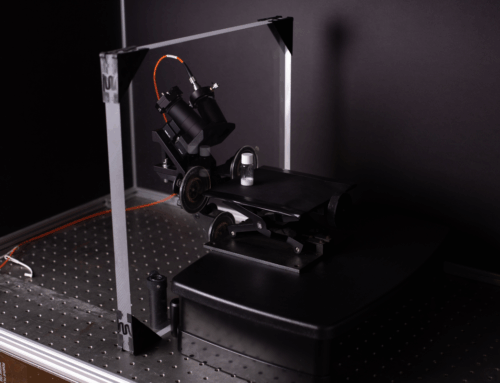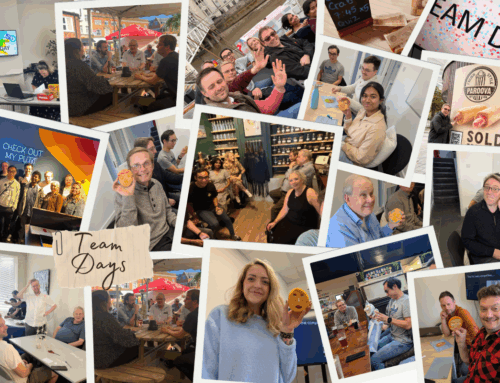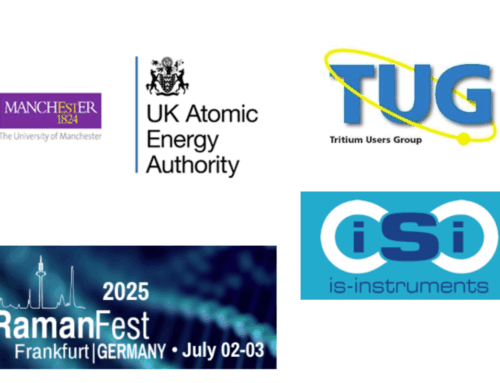Last week, Jessica Gabb represented IS-Instruments at the 16th International Symposium on Fusion Nuclear Technology (ISFNT-16) in Knoxville, Tennessee. The event brought together global leaders in fusion research, fuel-cycle science, and nuclear engineering. It also offered the ideal stage to showcase the progress of our gas Raman instrument, which can detect and distinguish between protium, deuterium, and tritium.
This capability represents a significant advancement for fusion diagnostics. It reflects almost a decade of collaboration between IS-Instruments, the Optoelectronic Research Centre (ORC), and Amentum. This is supported by the UK Atomic Energy Authority’s Fusion Industry Programme through the GRADE project.
In short, we are developing an instrument that can help fusion become safer, cleaner, and more measurable.
A Full Week of Fusion Insight
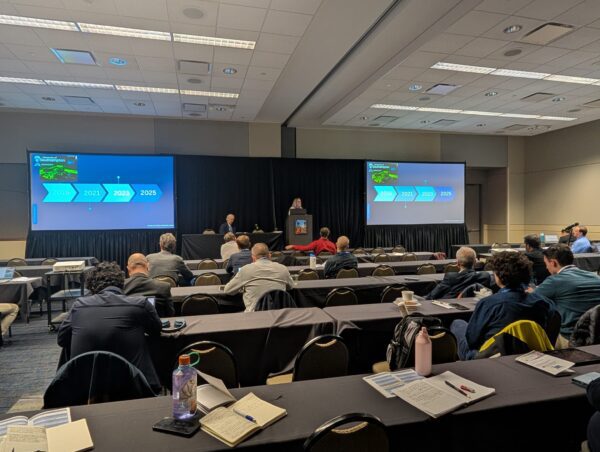 ISFNT-16 opened on Monday with a long first day, running from 8:00 a.m. to 6:30 p.m. Mornings focused on plenary talks, featuring invited speakers and panel discussions. Afternoons shifted to parallel technical sessions, where researchers shared the latest breakthroughs and experimental work.
ISFNT-16 opened on Monday with a long first day, running from 8:00 a.m. to 6:30 p.m. Mornings focused on plenary talks, featuring invited speakers and panel discussions. Afternoons shifted to parallel technical sessions, where researchers shared the latest breakthroughs and experimental work.
Jessica’s presentation on the gas Raman system took place early in the week and was well-received. Many attendees were keen to learn how the instrument rapidly detects hydrogen isotopologues. Simultaneous detection offers a significant advantage over traditional gas-sampling techniques, which often require slower or more complex analysis methods.
The results, drawn from years of development and testing, highlighted the potential of Raman spectroscopy to support future monitoring of fusion fuel cycles.
The GRADE Gas Raman Instrument
The gas Raman instrument was developed in 2015 as part of the ArMOF project. This was an Optoelectronics Research Centre (ORC) initiative to design an instrument capable of measuring gas compounds in industrial applications. Now the focus of the GRADE project, it is being developed as a collaboration between the ORC and Amentum. We aim to use Raman spectroscopy to measure tritium and other hydrogen isotopologues with high accuracy and stability. Earlier this year, the instrument successfully detected tritium in a glovebox at Amentum’s facilities. ORC’s expertise in microstructured hollow-core fibre has been crucial. These fibres allow laser light to interact with gas samples in a controlled way while maintaining the sensitivity needed for fuel-cycle applications.
The UKAEA Fusion Industry Programme has enabled the project to move from research to real-world relevance. The GRADE instrument is now progressing toward deployment in operational tritium environments – a step that could support future fusion reactors such as DEMO.
A Week of Highlights and Connections
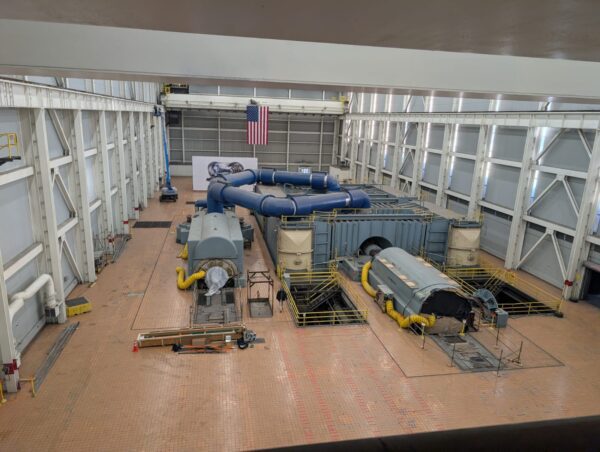 Wednesday afternoon offered a change of pace. Delegates had the opportunity to visit the planned site for Type One Energy’s Infinity One stellerator, the former Bull Run Fossil Plant, and the American Museum of Science and Energy (AMSE). Infinity One is their first reactor, a non-tritium demonstrator.
Wednesday afternoon offered a change of pace. Delegates had the opportunity to visit the planned site for Type One Energy’s Infinity One stellerator, the former Bull Run Fossil Plant, and the American Museum of Science and Energy (AMSE). Infinity One is their first reactor, a non-tritium demonstrator.
The AMSE provides an overview of the history of science and engineering projects conducted at Oak Ridge, beginning with the city’s involvement in the Manhattan Project. The tour helped contextualise the work happening across the conference and gave attendees a closer look at the infrastructure that will support future experiments.
Thursday night hosted the gala dinner. Jessica sat with representatives from CIEMAT, hosts of last year’s ISFNT, and enjoyed good conversations about future collaboration.
Throughout the week, Jessica built valuable connections:
She spoke with researchers from Oak Ridge National Laboratory and the Korea Institute of Fusion Energy, who invited her to share her presentation slides for their diagnostics teams.
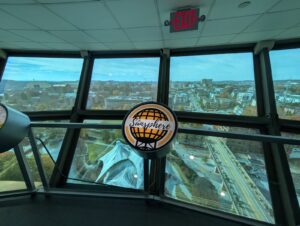
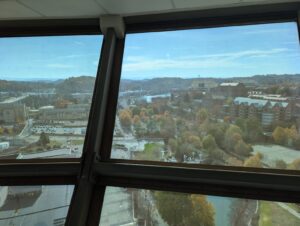 She caught up with Fatima from UKAEA, the technical lead for the GRADE project. They also visited the Sunsphere, an iconic 1982 World’s Fair landmark that offers panoramic views of Knoxville.
She caught up with Fatima from UKAEA, the technical lead for the GRADE project. They also visited the Sunsphere, an iconic 1982 World’s Fair landmark that offers panoramic views of Knoxville.
She exchanged insights with Emre Yildirim from Tokamak Energy. He was unable to attend her talk due to a scheduling conflict, so Jessica shared her slides afterwards.
Two plenary sessions stood out for her.
First, a talk by Brenda Garcia-Diaz, Director of FC FIRE (Fusion Cycle) at SRNL, who discussed the complexities of the fusion fuel cycle.
Second, a memorable presentation by Stephen Reynolds of UKAEA on gaseous tritium releases from JET during DTE2, with comparisons with DTE1 and non-tritium operations. His discussion included the UKAEA’s experiments, which involved growing vegetables around the site perimeter to track tritium uptake.
Early-Stage Work: The Stimulated Raman System
IS-Instruments is also exploring a second system based on stimulated Raman spectroscopy. This instrument is still in its early stages, but it shows strong promise.
While the GRADE instrument focuses on the fuel cycle, the stimulated Raman system is designed for leak detection. The aim is to achieve detection limits at the ppb to ppt level, sensitive enough to detect even the smallest tritium releases. In fusion environments, this matters. Tritium is both radioactive and strategically important, making leak detection essential for ensuring safety, accountability, and non-proliferation.
This work attracted significant interest at ISFNT, with many attendees recognising its potential to improve monitoring across future fusion facilities.
Bringing It All Together
ISFNT-16 reinforced the momentum building across the global fusion community. The plenaries showcased progress from major international organisations and highlighted how much of the current work feeds into the ITER design and the broader roadmap toward commercial fusion power. For IS-Instruments, the event demonstrated that Raman-based diagnostics are becoming an essential part of that future. Jessica’s presentation showed how far the technology has come – and how much more can still be achieved.
Next up is the Gas Analysis and Sensing Group (GasG) meeting in London on 4 December, where Jess will continue the conversation and share the latest developments.
Fusion is moving fast. IS-Instruments is proud to be helping shape the tools that will support the reactors of tomorrow.
This project has been supported by UK Atomic Energy Authority through the Fusion Industry Programme (FIP). FIP is stimulating the growth of the UK fusion ecosystem and preparing it for the future global fusion powerplant market. More information can be found online: https://ccfe.ukaea.uk/programmes/fusion-industry-programme/




